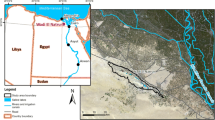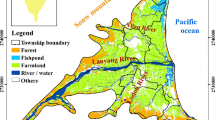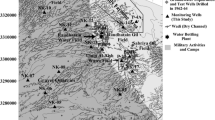Abstract
Sustainable use of groundwater must ensure not only that the future resource is not threatened by overuse, but also that natural environments that depend on the resource, such as stream baseflows, riparian vegetation, aquatic ecosystems, and wetlands are protected. To properly manage groundwater resources, accurate information about the inputs (recharge) and outputs (pumpage and natural discharge) within each groundwater basin is needed so that the long-term behavior of the aquifer and its sustainable yield can be estimated or reassessed. As a first step towards this effort, this work highlights some key groundwater recharge studies in the Kansas High Plains at different scales, such as regional soil-water budget and groundwater modeling studies, county-scale groundwater recharge studies, as well as field-experimental local studies, including some original new findings, with an emphasis on assumptions and limitations as well as on environmental factors affecting recharge processes. The general impact of irrigation and cultivation on recharge is to appreciably increase the amount of recharge, and in many cases to exceed precipitation as the predominant source of recharge. The imbalance between the water input (recharge) to the High Plains aquifer and the output (pumpage and stream baseflows primarily) is shown to be severe, and responses to stabilize the system by reducing water use, increasing irrigation efficiency, adopting water-saving land-use practices, and other measures are outlined. Finally, the basic steps necessary to move towards sustainable use of groundwater in the High Plains are delineated, such as improving the knowledge base, reporting and providing access to information, furthering public education, as well as promoting better understanding of the public’s attitudinal motivations; adopting the ecosystem and adaptive management approaches to managing groundwater; further improving water efficiency; exploiting the full potential of dryland and biosaline agriculture; and adopting a goal of long-term sustainable use.
Résumé
L’utilisation durable de l’eau souterraine doit permettre non seulement que la pérennité de l’eau ne soit pas menacée, mais aussi que les environnements naturels qui dépendent de cette ressource, tels que la végétation riveraine, les écosystemes aquatiques et les milieux humides, soient protégés. Afin d’assurer une gestion appropriée des ressources en eau souterraine, une information précise concernant les entrées (recharge) et les sorties (décharge naturelle et pompage) d’eau dans chacun des bassins est nécessaire afin que le comportement à long terme de l’aquifère et le taux de pompage durable puissent être estimés. En guise d’initiative, ce travail illustre certaines études clé concernant la recharge de l’eau souterraine à plusieurs échelles dans les hautes plaines du Kansas. Ces études comprennent le bilan sol-eau et la modélisation numérique à l’échelle régionale, l’étude de la recharge des nappes souterraines à l’échelle du comté, des études expérimentales à petite échelle et certaines découvertes originales. Lors de la présentation de ces études, l’emphase est portée sur les hypothèses et limitations ainsi que sur les facteurs environmentaux qui affectent les processus de recharge. En général, les effets de l’irrigation et de l’agriculture sur la recharge sont d’augmenter considérablement le taux de recharge, et dans plusieurs cas, d’excéder les précipitations comme principale source de recharge. Le déséquilibre entre les intrants d’eau (recharge) et entrants (pompage et écoulement de base dans les rivières) dans l’aquifère des hautes plaines est très important. Les résultats des efforts de stabilisation du système aquifère en diminuant l’utilisation d’eau, en améliorant l’efficacité des techniques d’irrigation, en adoptant des pratiques d’utilisation du territoire qui réduisent l’utilisation d’eau et en adoptant certaines autres mesures sont présentés. Enfin, les étapes de base nécessaires afin d’atteindre une utilisation durable de l’eau souterraine dans les hautes plaines sontexposées. Elles comprennent l’amélioration des connaissance de base, lapromotion d’une meilleure compréhension de la motivation et de l’attitudedu public, l’adoption d’une approche de gestion de l’eau souterraineadaptable et basée sur les écosystèmes, l’amélioration de l’efficacitéd’utilisation de l’eau, l’exploitation du plein potentiel de l’agriculturebiosaline et en milieu aride, et l’adoption d’un objectif pourl’utilisation durable à long terme.
Resumen
El uso sostenible de aguas subterráneas debe garantizar tanto que el recurso futuro no esté amenazado por sobreutilización como que los ambientes naturales dependientes del recurso sean protegidos (ie el flujo base de los arroyos, la vegetación ripariana, los ecosistemas acuáticos y los pantanos). El manejo adecuado de los recursos de aguas subterráneas requiere información precisa con respecto a los influjos (recarga) y descargas (bombeo y descarga natural) en cada cuenca de aguas subterráneas de tal manera que se pueda estimar o reevaluar el comportamiento de largo plazo del acuífero y su tasa de sotenibilidad. En un primer paso hacia esta meta, este trabajo destaca algunos estudios claves de recarga de aguas subterráneas en las llanuras altas de Kansas. Dichos estudios se concentran en diferentes escalas: estudios regionales del presupuesto para aguas del suelo y modelos de aguas subterráneas, estudios de recarga de aguas subterráneas a nivel provincial y estudios locales experimentales de terrenos que incluyen algunos interesantes descubrimientos nuevos. Estas investigaciones comparten el énfasis en los presupuestos de partida y las limitaciones así como en los factores ambientales que afectan los procesos de recarga. El impacto general de las irrigaciones y cultivos sobre la recarga es un obvio incremento en el monto de recarga y en muchos casos excede a la precipitación como la fuente principal de recarga. Se puede observar que el desequilibrio entre el influjo de agua (recarga) del acuífero de las llanuras altas y la descarga (bombeo y flujos base de los arroyos principalmente) es severo. Asimismo, se describen las respuestas para estabilizar el sistema a través de la reducción del uso de agua por medio del incremento de la eficiencia de las irrigaciones y de la adopción de las prácticas de ahorro de agua y del uso de tierras así como otras medidas adicionales. Finalmente se describen los pasos básicos necesarios para evolucionar hacia el uso sostenible de las aguas subterráneas en las llanuras altas de Kansas. Estos pasos están constituidos por una mejora del conocimiento base, comunicar y proporcionar fácil acceso a la información, mejorar el conocimiento público general así como promover un mejor entendimiento de las motivaciones para las actitudes de la comunidad, adoptar los enfoques administrativos de ecosistemas y administración adaptable en el manejo de las aguas subterráneas, continuar las mejoras del uso eficiente del agua, explotar el potencial de la agricultura de terrenos áridos y biosalina y adoptar como meta el uso sostenible a largo plazo.



Similar content being viewed by others
References
Al-Attar M (2002) Role of biosaline agriculture in managing freshwater shortages and improving water security. http://www.worldfoodprice.org/Symposium/2002presentations/Al-Attar.pdf
Blaney HF, Criddle WD (1962) Determining consumptive use and irrigation water requirements. US Dept of Agriculture, Tech Bull 1275:59
Brehehoeft JD (2002) The water budget myth revisited: why hydrogeologists model. Ground Water 40(4):340–345
Bredehoeft JD, Papadopulos SS, Cooper HH Jr. (1982) The water budget myth. In: Scientific basis of water resource management: studies in geophysics. National Academy, Washington, DC, pp 51–57
Cook PG, Herczeg AL, Harrington GA (2001) Is groundwater sustainability possible? Pre-print from 2001 A Water Odyssey, Australian Water Association, 19th Federal Convention, 1–5 April, 2001, Canbera, Australia
Cook PG, Walker GR, Jolly ID (1989) Spatial variability of groundwater recharge in a semiarid region. J Hydrol 111:195–212
CAST (1988) Effective use of water in irrigated agriculture. Council for Agricultural Science and Technology Report no. 113, Washington, DC
Dugan JT, Peckenpaugh JM (1985) Effects of climate, vegetation, and soils on consumptive water use and groundwater recharge to the Central Midwest Regional Aquifer System, Mid-Continent United States. US Geological Survey Water Resources Investigations Report 85-4236, Reston, Virginia, 78 pp
Dugan JT, Zelt RB (2000) Simulation and analysis of soil-water conditions in the Great Plains and adjacent areas 1951–80. US Geological Survey Water-Supply Paper 2427, USGS, Reston, Virginia, 81 pp
Eklund DL, Jawa DS, Rajala TK (1999) Evaluation of the western Kansas weather modification program. J Weather Mod 31:91–101
Ellis JR, Lacewell RD, Reneau DR (1985) Economic implications of water-related technologies for agriculture: Texas High Plains. Texas Agricultural Experiment Station MP-1577. Texas A & M University, College Station, Texas
Gilley JR, Fereres-Castiel E (1983) Efficient use of water on the farm. In: Water related technologies for sustainable agriculture in U.S. arid/semi-arid lands. OTA-F-212. US Congress, Office of Technology Assessment, Washington DC
Gutentag ED, Heimes FJ, Krothe NC, Luckey RR, Weeks JB (1984) Geohydrology of the High Plains aquifer in parts of Colorado, Kansas, Nebraska, New Mexico, Oklahoma, South Dakota, Texas, and Wyoming. US Geological Survey, Professional Paper 1400-B, USGS, Reston, Virginia, 63 pp
Hansen CV (1991) Estimates of freshwater storage and potential natural recharge for principal aquifers in Kansas. Water-Resources Investigations Report 87–4230, USGS, Reston, Virginia, 100 pp
Hargedine GD, Balsters RG, Luehring J (1978) Mineral intrusion in Kansas surface waters: a technical report. Kansas Water Quality Management Plan, Kansas Water Resources Board, Topeka, Kansas, 211 pp
Harremoës P, Gee D, MacGarvin M, Stirling A, Keys J, Wynne B, Vaz SG (eds) (2002) The precautionary principle in the 20th century: late lessons from early warnings. European Environment Agency, Earthscan, London, 268 pp
Heimes FJ, Luckey RR (1982) Method of estimating historical irrigation requirements from ground water in the High Plains of Colorado, Kansas, Nebraska, New Mexico, Oklahoma, South Dakota, Texas, and Wyoming. US Geological Survey Water-Resources Investigations Report 82-40, USGS, Reston, Virginia, 64 pp
Jenkins RWG, Edwards SR (2000) Sustainable use of wild species: a guide for decision makers. 5th Meeting of the Conference of the Parties to the Convention on Biological Diversity, May 15–26, 2000, Nairobi, Kenya, 13 pp
Jolly ID, Cook PG, Allison GB, Hughes MW (1989) Simultaneous water and solute movement through an unsaturated soil following an increase in recharge. J Hydrol 111:391–396
KWRB (Kansas Water Resources Board) (1967) Irrigation in Kansas. 701 project no. Kans P-43 Report 16(e), State of Kansas, Planning for Development, Topeka, Kansas, 128 pp
Kromm DE, White SE (1992) Groundwater problems. In: Kromm DE, White SE (eds) Groundwater exploitation in the High Plains, University of Kansas Press, Lawrence, Kansas, pp 44–63
Luckey RL, Becker MF (1999) Hydrogeology, water use, and simulation of flow in the High Plains aquifer in northwestern Oklahoma, southeastern Colorado, southwestern Kansas, northeastern New Mexico, and northwestern Texas. US Geological Survey Water-Resources Investigations Report 99–4104, USGS, Reston, Virginia, 68 pp
Luckey RL, Gutentag ED, Heimes FJ, Weeks JB (1986) Digital simulation of ground-water flow in the High Plains aquifer in parts of Colorado, Kansas, Nebraska, New Mexico, Oklahoma, South Dakota, Texas, and Wyoming. Professional Paper 1400-D, USGS, Reston, Virginia, 57 pp
McDonald MG, Harbaugh AW (1988) A modular three-dimensional finite-difference ground-water flow model. Techniques of Water Resources Investigations, vol 6, chapter A1, USGS, Reston, Virginia
McMahon PB, Dennehy KF, Michel RL, Sophocleous MA, Ellett KM, and Hurlbut DB (2003) Water movement through thick unsaturated zones overlying the central High Plains aquifer, southwestern Kansas, 2000–2001. Water-Resources Investigations Report 03–4171, USGS, Reston, Virginia, 32 pp
Meyer WR, Gutentag ED, Lobmeyer DH (1970) Geohydrology of Finney County, southwestern Kansas. US Geological Survey Water-Supply Paper 1891, USGS, Reston, Virginia, 117 pp
NRC (1996) A new era for irrigation. National Research Council, National Academy, Washington DC, 216 pp
NRC (2000) Investigating groundwater systems on regional and national scales. National Research Council, National Academy, Washington DC, 143 pp
Opie J (2000) Ogallala: water for a dry land, 2nd edn. University of Nebraska Press, Lincoln, Nebraska, 475 pp
Prill RC (1968) Movement of moisture in the unsaturated zone in a dune area, southwestern Kansas. US Geological Survey Professional Paper 600-D: D1-D9, USGS, Reston, Virginia
Prill RC (1977) Movement of moisture in the unsaturated zone in a loess-mantled area, southwestern Kansas. US Geological Survey Professional Paper 1021, USGS, Reston, Virginia, 21 pp
Rosegrant MW, Cai X, Cline SA (2002) Global water outlook to 2025: averting an impending crisis. International Food Policy Research Institute (IFPRI)-2020 vision, International Water Management Institute, Washington DC, 26 pp
Ramireddygari SR, Sophocleous MA, Koelliker JR, Perkins SP, Govindaraju RS (2000) Development and application of a comprehensive simulation model to evaluate impacts of watershed structures and irrigation water use on streamflow and groundwater: the case of Wet Walnut Creek Watershed, Kansas, USA. J Hydrol 236(3–4):223–246
Schloss JA, Buddemeier RW, Wilson BB (eds) (2000) An atlas of the Kansas High Plains aquifer. Educational Series 14, Kansas Geological Survey, Wichita, Kansas, 92 pp
Sophocleous MA (1992) Groundwater recharge estimation and regionalization: the Great Bend Prairie of central Kansas and its recharge statistics. J Hydrol 137(1–4):113–140
Sophocleous MA (1997) Managing water resources systems: why “safe yield” is not sustainable. Ground Water 35(4):561
Sophocleous MA (1998a) Water resources of Kansas−a comprehensive outline. In: Sophocleous MA (ed) Perspectives on sustainable development of water resources in Kansas. Kansas Geol Surv Bull 239:1–59
Sophocleous MA (1998b) On the elusive concept of safe yield and the response of interconnected stream-aquifer systems to development. In: Sophocleous MA (ed) Perspectives on sustainable development of water resources in Kansas, Kansas Geol Surv Bull 239: 60–85
Sophocleous MA (2000a) From safe yield to sustainable development of water resources: the Kansas experience. J Hydrol 235(1–2):27–43
Sophocleous MA (2000b) The origin and evolution of safe yield policies in the Kansas groundwater management districts. Natural Resources Research 9(2):99–110
Sophocleous MA (2000c) Quantification and regionalization of ground-water recharge in south-central Kansas: integrating field characterization, statistical analysis, and GIS. Spec Issue, Compass 75(2–3):101–115
Sophocleous MA (2002) Interactions between groundwater and surface water: the state of the science. Hydrogeol J 10(1):52–67
Sophocleous MA (2003) Environmental implications of intensive groundwater use with special regard to streams and wetlands. In: Custodio E, Llamas R (eds) Groundwater intensive use: challenges and opportunities. Balkema, Lisse, The Netherlands, pp 93–112
Sophocleous MA (2004) Groundwater recharge and water budgets of the Kansas High Plains and related aquifers. Kansas Geol Surv Bull 249:1–102
Sophocleous MA, McAllister JA (1987) Basinwide water-balance modeling with emphasis on spatial distribution of ground-water recharge. Water Resour Bull 23(6):997–1010
Sophocleous MA, McAllister JA (1990) Hydrologic-balance modeling of the Rattlesnake Creek watershed, Kansas. Ground Water Series, Kansas Geological Survey, Wichita, Kansas, vol 11, 72 pp
Sophocleous MA, Perkins SP (2000) Methodology and application of combined watershed and groundwater models in Kansas. J Hydrol 236(3–4):185–201
Sophocleous MA, Koelliker JK, Govindaraju RS, Tiraz B, Ramireddygari SR, Perkins SP (1999) Integrated numerical modeling of basin-wide water management: the case of the Rattlesnake Creek basin in south-central Kansas. J Hydrol 214(1–4):179–196
Sophocleous MA, Kluitenberg GJ, Healey J (2002) Southwestern Kansas High Plains deep vadose zone pilot study to estimate Darcian-based groundwater recharge at three instrumented sites. Kansas Geological Survey Open-File Report 2001–11, KGS, Wichita, Kansas, 120 pp
US Department of Commerce (1949–92) Census of agriculture: Bureau of the Census, agricultural data for 1949, 1954, 1959, 1964, 1969, 1974, 1978, 1982, 1987, and 1992 for Colorado, Kansas, New Mexico, Oklahoma, and Texas. US Government Printing Office, Washington, DC
US Department of Commerce, Bureau of the Census (1980) Census of agriculture, 1978, County data (by State). US Government Printing Office, Washington, DC
van Genuchten MTh, Simunek J, Leij FJ, Sejna M (1998) RETC, version 6.0: code for quantifying the hydraulic functions of unsaturated soils. Available at http://www.ussl.ars.usda.gov/MODELS/netc.html
Zelt RB, Dugan JT (1993) Simulation and mapping of soil-water conditions in the Great Plains. Water Resour Bull 29(6):939–948
Acknowledgments
Funding support for this study by the Kansas Water Resources Institute is gratefully acknowledged. The author is indebted to the reviewers of the Hydrogeology Journal Thomas Burbey, Richard Luckey, and Assoc. Editor Ken Belitz, and the following individuals who read and commented on this paper: Susan Stover (Kansas Water Office), Allen Macfarlane, Rex Buchanan, Liz Brozius, Brownie Wilson (Kansas Geological Survey), and Rick Devlin (Dept. of Geology, The University of Kansas).
Author information
Authors and Affiliations
Corresponding author
Rights and permissions
About this article
Cite this article
Sophocleous, M. Groundwater recharge and sustainability in the High Plains aquifer in Kansas, USA. Hydrogeol J 13, 351–365 (2005). https://doi.org/10.1007/s10040-004-0385-6
Received:
Accepted:
Published:
Issue Date:
DOI: https://doi.org/10.1007/s10040-004-0385-6




